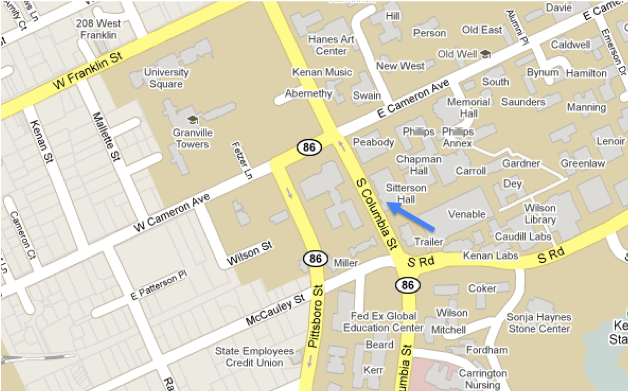AlgorithmRetreat2010
From NAMIC Wiki
Home < AlgorithmRetreat2010
Back to brainstorming page Back to events page
Contents
Nov 5-6, Chapel Hill, NC
Introduction
- The NA-MIC algorithm core holds an annual retreat
- The 2010 event will begin on 8:30 am on Friday the 5th of Nov and finish at approximately 2pm on Saturday the 6th.
- Meeting location: SittersonHall/Brooks Building, chair's conference room, FB120 (first floor)
- If you have problems finding it, give Martin a call (919-260-6674)
Agenda
Friday
- 8:30 meet in Chair's conference room, Brooks Building, coffee
- 9-10 DBP updates, data availability, each 15 minutes
- 10-10:30 DBP common themes, differences, what is missing
- 10:30-12 Overview of Core 1 site short and long term plans (each 15 min)
- noon lunch
- student presentations of exciting ideas, 10-20 minutes
- Yi Gao, region competition segmentation, particle diffeo/polyaffine registrations
- Sam Gerber, brain image manifolds
- Romeil Sandhu, filtered registration
- Michal Depa, arterial segmentation
- Archana Venkataraman
- Ross Whitaker
- Martin Styner
- Marc Niethammer
- 1-5 Discussions on longitudinal & personalized registration, segmentation topics, shape topics
Saturday
- 8:30 meet & coffee, meeting first in front of Sitterson Hall (doors are closed on Saturday)
- 9-11 Slicer
- Ron will give an update on Slicer 3.6.2 and Slicer 4, extensions
- Extensions:
- Ron will give an update on Slicer 3.6.2 and Slicer 4, extensions
- If your algorithm can be delivered as a CLI, then develop and deploy it now as an extension for 3.6 and the nightly builds. This will transition smoothly to slicer4.
- If your algorithm requires interactivity then
- If you want to deploy it within the next 6 months, then consider a python or tcl scripted wizard interface to CLI code, knowing that there will be some porting required.
- if a wizard isn't interactive enough, consider a custom kwwidgets interface, knowing that this will be difficult to port to slicer4
- if your deployment target is 6 or more months out, you should begin working with the slicer4 Qt developer build starting in January.
- Most of the DBP projects fall under rule 3. If a CLI plug-in is the end result, then 3.6 is still a good target for now.
- Ron will give a demo of Changetracker, GrowCutSegment (Harini's charts on GrowCut and Active Learning), Fastmarching.
- Allen and Yi Gao will demo RSS
- Discussion on interactive issues, what level of interaction, how to mesh those with Slicer
- 11-12 AHM planning
- noon lunch on Franklin street
- 1-2 summary, make up slot
Topics
- Plans, Needs, Expectations of and Interactions with DBPs (Core-1 contacts, all)
- Actions items for the AHM
- Plans for the next 12 months
- Segmentation
- Registration
- Upcoming event: New Directions in Registration Workshop
- Other algorithm classes
- Shape
- Interactive algorithms
- Interaction with the Engineering Core
- See whitepaper about the interactions between Cores 1a, 1b, and 2.
- Suggested activities for Jan 2011 Project Week
Suggested Hotels
Nice for walking to campus & Franklin Street, but rather expensive (ask for the University/Computer Science rate of 159 USD per night):
- Carolina Inn, 211 Pittsboro Street, Chapel Hill, NC
- Franklin Hotel, 311 W Franklin St, Chapel Hill, NC
Best suggestions (need taxi or rental car to campus & Franklin Street):
- Courtyard Marriott, 100 Marriott Way, Chapel Hill, NC
- Days Inn, 15-501 & Fordham Blvd, Chapel Hill, NC 27514 US
Attendees
- Ross Whitaker, Utah
- Guido Gerig, Utah
- Polina Golland, MIT
- Allen Tannenbaum, Georgia Tech
- Martin Styner, UNC
- Ipek Oguz, UNC
- Marc Niethammer, UNC
- Ron Kikinis (Saturday only)
- Michal Depa, MIT
- Archana Venkataraman, MIT
- Sam Gerber, Utah
- Marcel Prastawa, Utah
- Yi Gao, Georgia Tech
- Romeil Sandhu, Georgia Tech
Notes from Meeting
DBP Updates
- Iowa: Martin S is the point of contact. Several visits have been exchanged. The engineer is working with Iowa/UNC. Data sets are available for structural and DTI. The goal is to predict time of onset of symptoms from imaging biomarkers. Functional data is not yet available but will be requested.
- Utah: Data is not yet available. Discussions of open technical problems include: segmentation of blood pool and fibrosis, registration of surfaces to probe-generated point sets, and longitudinal registration of multiple MRIs. Action item: Ross will discuss with Rob getting the data and getting an engineer on board. Ross will facilitate exchange of code data between CARMA group and Polina's group for blood pool segmentation.
- UCLA: Data is available, but there was some question about where it would be hosted and how. The emphasis is on a set of manually driven tools for quickly outlining or annotating regions of interest and being able to compare compare subjects at multiple time points with different modalities.
- Harvard: Greg S is the engineer and is actively engaged. The challenge appears to be a great deal of variability in deformation/geometry, even between different scans of the same patient. The agreement is that Greg S will grab (from a very large archive) several dozen cases that include longitudinal scans, and this will be made available to NAMIC C1a.
